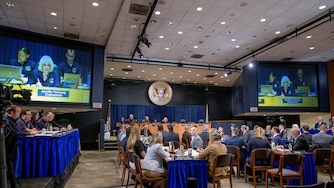Staff have lost jobs. Faculty grants have vanished. Graduate programs have stopped accepting as many students.
The Johns Hopkins University faces a dramatic loss of up to $1 billion — so far — amid the Trump administration’s cuts to research, foreign aid and higher education.
On Monday, the university announced it was using some of its endowment earnings to temporarily replace some federal grants, a rare stopgap measure to sustain what the university considers critical research.
Here’s what you need to know about the highly unusual move and how endowments work.
What is an endowment?
Most nonprofits, from colleges to hospitals to zoos, have endowments.
An endowment is a collection of donated funds that the college invests to support its mission for years to come.
Read More
“Those that give to an endowment want the institution to be able to rely on their gift forever,” said Liz Clark, vice president for policy and research for the National Association of College and University Business Officers. “If invested properly, it will keep growing.”
That means Hopkins’ $13 billion endowment is not just sitting in a savings account.
Universities invest their endowments so that the money doesn’t run out. The investments are set up so that the college can withdraw some of the money every year, but not all of it. They’re a long-term financial strategy not intended to be used as rainy-day funds for emergencies like federal funding cuts.
How much do endowments make every year?
Like any investment, an endowment can yield big returns or lose money from year to year, depending on market fluctuations and how leaders decided to invest the funds.
The years following the coronavirus pandemic saw some of the biggest fluctuations in average endowment returns. In 2021, colleges got an average of 20.6% of the endowment money they invested, but then lost an average of 8% the following year.
To weather economic ups and downs, colleges spend their endowment returns in ways that might seem counterintuitive. When investment returns are higher, colleges don’t spend as much. When the economy is worse and endowments pull in less money, like during the Great Recession, for example, colleges tend to increase spending endowment dollars.
How does Hopkins’ endowment compare to those of other colleges?
Hopkins has a much larger endowment than most other universities.
Data from the National Center for Education Statistics shows that by the end of fiscal year 2022, the majority of four-year colleges had endowments of less than $50 million or no endowment at all. Among colleges that do have endowments, the average is roughly $43.3 million.
“The larger an endowment is, the more revenue that the institution will be able to pull yearly,” Clark explained.
A university like Hopkins is able to draw much more per year than a college with a smaller endowment, like Mount St. Mary’s, which has a $59.2 million endowment.
The largest university endowment in the country is Harvard University’s, which sits at about $53 billion.
How much money does Hopkins take out of its endowment every year?
Hopkins takes out between 4.5% and 5.5% of its endowment yearly, which is pretty standard across most colleges and universities.
That means that every year, the university gets between $594 million to $726 million to spend towards its operating budget.
The university hasn’t shared how much of its endowment it will take out this year to help offset federal funding losses.
Why can’t Hopkins use more of its endowment this year to help offset the loss of federal funding?
Here’s where things get tricky.
While Hopkins might take out $726 million this year, a lot of the money is restricted, meaning it can only be used for specific programs, according to Hopkins’ financial statements. When a donor gives money, it’s often for a certain academic program or financial aid, for example.
The endowment, according to recent financial documents released by the university, has approximately 4,700 different funds.
Hopkins is unlikely to just take out $1 billion of its endowment to help plug federal funding gaps. The university needs to reinvest its endowment to make sure that the pot of money continues to grow, keep up with inflation and sustain itself.
How does the Republican-controlled federal government want to change endowments?
Some politicians are in favor of taxing endowments, which is “really unprecedented,” Clark said, because nonprofit colleges are tax exempt.
In 2017, Congress implemented the first-ever endowment excise tax, applying a 1.4% tax on endowment income for universities with at least $500,000 per student in endowment funds.
That didn’t impact Hopkins, but it did affect other wealthy universities like Harvard and Yale.
“For colleges and universities, the tax simply takes away from the revenues that they have to support scholarships, faculty salaries, research and investments,” Clark warned.
There are two proposals this year, both by Republican congressmen, to increase that tax.
New York Congressman Mike Lawler introduced a bill in February to lower the per-student endowment threshold from $500,000 to $200,000 and raise the excise tax rate from 1.4% to 10% of endowment income.
Congressman Troy Nehls wants to go a step further. The Texas representative proposed a bill in January which would raise the tax to 21%.
If either of those bills were to pass, Hopkins would see its endowment taxed. That, Clark said, would likely mean less money to go to student financial aid, academic programs and more.
About the Education Hub
This reporting is part of The Banner’s Education Hub, community-funded journalism that provides parents with resources they need to make decisions about how their children learn. Read more.





Comments
Welcome to The Banner's subscriber-only commenting community. Please review our community guidelines.